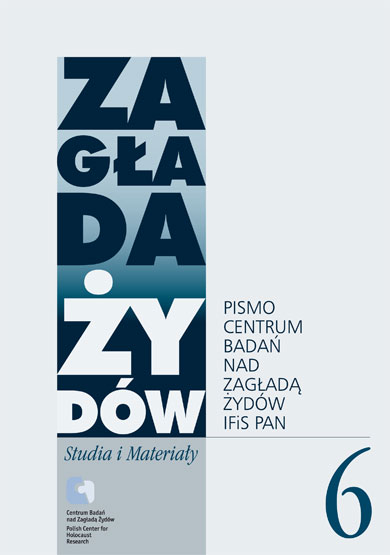Kicz i Holokaust, czyli pedagogiczny wymiar ekspozycji muzealnych
Zagłada Żydów. Studia i Materiały, Nr 6 (2010), Strony: 74-86
Data zgłoszenia: 2020-12-06Data publikacji: 2010-12-30
 https://doi.org/10.32927/zzsim.707
https://doi.org/10.32927/zzsim.707
Abstrakt
Museum exbibition is a medium consisting of multiple media but the whole is something more that the sum of its parts. Each exhibition is a kind of spectacle, a specific cultural creation, and it works according to its own rules. An exhibition is also the core of museum experience and, as such, it should be subject to multidimensional analysis. Meanwhile, the content of an exhibition and the material used in its construction are often assessed, and very little is said about it as a form of expression and the specific character of its influence on the public. In the article I analyze the exhibition in the United States Holocaust Memorial Museum in Washington in terms of the kitsch category. The term itself is hardly precise and it is multidimensional. Therefore I define it for the purposes of the and test to what extent it can be used to interpret goals and principles of assumptions behind historical exhibition dedicated to the Holocaust. The article is an exemplary interpretation of exhibition’s poetics and policy and it aims at demonstrating how pedagogical functions of museum exhibitions about the Holocaust may reduce its dimension to a lesson on intolerance.
Słowa kluczowe
Holokaust , reprezentacja , ekspozycja , kicz , pedagogika
Licencja
Prawa autorskie (c) 2010 Autor & "Zagłada Żydów. Studia i Materiały"

Utwór dostępny jest na licencji Creative Commons Uznanie autorstwa 4.0 Międzynarodowe.
https://creativecommons.org/licenses/by/4.0
Podobne artykuły
- Mirosław Skrzypczyk, Robert Szuchta, Piotr Trojański, Holokaust. (Nie)odrobiona lekcja historii , Zagłada Żydów. Studia i Materiały: Nr 20 (2024)
- Jacek Leociak, Marta Tomczok, Afektywny kicz holokaustowy – wprowadzenie , Zagłada Żydów. Studia i Materiały: Nr 17 (2021)
- Adam Puławski, Uwagi i refleksje wokół wydawnictwa edukacyjnego Zrozumieć Holokaust , Zagłada Żydów. Studia i Materiały: Nr 9 (2013)
- Robert Szuchta, Piotr Trojański, Jak pisać podręczniki szkolne o Zagładzie? Na marginesie recenzji książki pt. Zrozumieć Holokaust , Zagłada Żydów. Studia i Materiały: Nr 9 (2013)
- Paweł Szypulski, Janina Struk, Holokaust w fotografiach. Interpretacja dowodów , Zagłada Żydów. Studia i Materiały: Nr 3 (2007)
- Natalia Sineaeva-Pankowska, Pamięć o Holokauście w Mołdawii , Zagłada Żydów. Studia i Materiały: Nr 11 (2015)
- Katarzyna Odrzywołek, Piotr Trojański, Dzieci Teheranu – od mrozów Syberii do słońca Palestyny. Rola delegatur Ambasady RP w ZSRR i Armii gen. Andersa w ratowaniu dzieci żydowskich , Zagłada Żydów. Studia i Materiały: Nr 11 (2015)
- Martyna Grądzka-Rejak, Zoë Waxman, Kobiety Holocaustu , Zagłada Żydów. Studia i Materiały: Nr 16 (2020)
- Marek Edelman, In memoriam - Marek Edelman , Zagłada Żydów. Studia i Materiały: Nr 5 (2009)
- Aleksandra Ubertowska, Nowe geografie, podmioty i media w studiach nad Zagładą. A Companion to the Holocaust , Zagłada Żydów. Studia i Materiały: Nr 17 (2021)
Możesz również Rozpocznij zaawansowane wyszukiwanie podobieństw dla tego artykułu.
 English
English
 Język Polski
Język Polski








